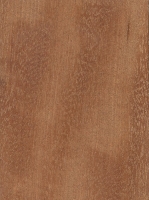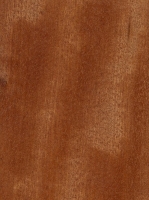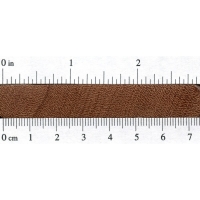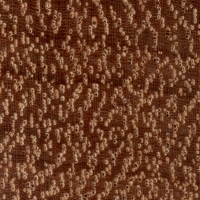 |
Common Name(s): Moabi, African Pearwood Scientific Name: Baillonella toxisperma Distribution: Equatorial Africa Tree Size: 165-200 ft (50-60 m) tall, 5-8 ft (1.5-2.5 m) trunk diameter Average Dried Weight: 54 lbs/ft3 (860 kg/m3) Specific Gravity (Basic, 12% MC): .71, .86 Janka Hardness: 1,790 lbf (7,960 N) Modulus of Rupture: 23,240 lbf/in2 (160.3 MPa) Elastic Modulus: 2,416,000 lbf/in2 (16.66 GPa) Crushing Strength: 10,560 lbf/in2 (72.8 MPa) Shrinkage: Radial: 6.2%, Tangential: 8.0%, Volumetric: 14.0%, T/R Ratio: 1.3 |
Color/Appearance: Heartwood is a rather uniform pinkish brown, sometimes darker reddish brown. Color tends to darken with age. Sapwood is grayish brown. Figured grain patterns are also seen, such as pommele, quilted, mottled, and beeswing.
Grain/Texture: Grain is straight to wavy. With a fine, even texture.
Endgrain: Diffuse-porous; solitary and radial multiples; large pores arranged in radial/diagonal pattern, few; parenchyma reticulate; narrow rays, spacing fairly close.
Rot Resistance: Rated as very durable; good insect resistance.
Workability: Generally easy to work with hand or machine tools, though figured wood is much more prone to chipping and tearout in machining operations. Also, Moabi has a high silica content, and will rapidly dull cutting edges, especially tool steel. Turns, glues, and finishes well. Responds well to steam bending.
Odor: No characteristic odor.
Allergies/Toxicity: Although severe reactions are quite uncommon, Moabi has been reported to cause eye and nose irritation. See the articles Wood Allergies and Toxicity and Wood Dust Safety for more information.
Pricing/Availability: Occasionally seen as lumber or decorative veneers. Prices should be moderate for an imported hardwood, though highly figured lumber or veneers are much more expensive.
Sustainability: This wood species is not listed in the CITES Appendices, but is on the IUCN Red List. It is listed as vulnerable due to a population reduction of over 20% in the past three generations, caused by a decline in its natural range, and exploitation.
Common Uses: Veneer, turned objects, fine furniture, cabinetry, and small specialty items.
Comments: Sometimes called African Pear, though the wood bears little botanical relation to true Pear (Pyrus genus). Moabi is a very large African tree, frequently yielding figured lumber and veneer; not too unlike Makore.
None available.








Looks like this wood is being sold as wood for decks, under the brand name Makossa (R). Suggest adding that name to the entry for this wood so that it will show up when other search for it.